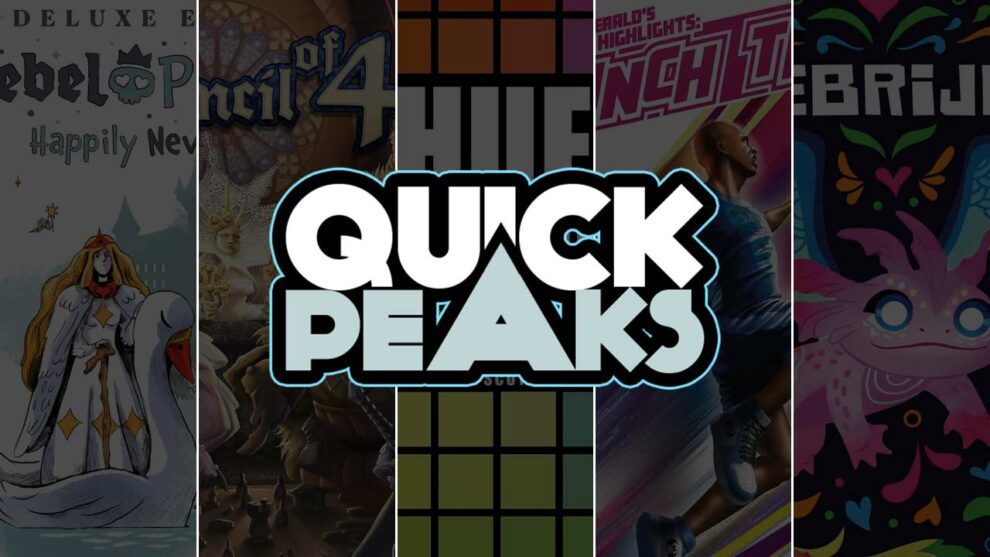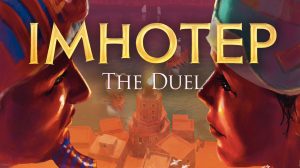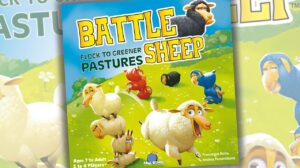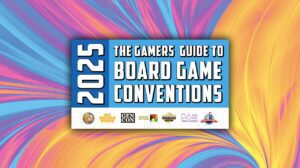Rebel Princess: Happily Never After – Andrew Lynch
Justin isn’t alone. I too love Rebel Princess, a spin on hearts in which the rules change every round. It isn’t for everyone; each player gets a Princess whose power can throw everything off, and those powers can be hard to track for people who aren’t used to the modern gaming ecosystem. If it is a game for you, though, it’s a joy.
Happily Never After adds a handful of new rules and a smaller handful of new Princesses, and they’re all great additions. This is a great example of a Just Shuffle It In expansion, the kind where no new rules are added and nothing more needs to be learnt. You can pick this up, mix it in with your base game, and never think about the fact that there’s an expansion in there again. It’s perfect.
Ease of entry?
★★★★★ – No sweat
Would I play it again?
★★★★★ – Will definitely play it again
Read more articles from Andrew Lynch.
Council of 4 – Andy Matthews
I remember seeing the original version of Council of Four ten years ago or so, and thought it looked really nifty. Then I promptly forgot about it. Then a few years later CMON released a new, dramatically overproduced version of the game, which brought it back to the forefront for a bit. Fast forward to earlier this year when I was lucky to find a copy in a local board game flea market and decided to pick it up.
In Council of Four players attempt to collect business contracts for various regions and cities around a fictional kingdom, then build networks of your merchants to earn points. You can earn points for being the first player to place merchants into all purple or yellow cities, or the first to place merchants in all cities in the forest region, etc. But in addition to earning bonuses for placing a merchant into a city, you also earn bonuses from any cities which have one of your merchants and are connected to the just placed merchant by roads. As you might expect this has a compounding effect and acts like a pinball on your dopamine receptors.
Council of Four has a lot going for it, and I’d definitely love the chance to play again at some point. The only downside is that the CMON version uses miniatures for every player piece, which means that the cleanup is quite some-consuming because there are trays for every set of pieces. I’m considering just tossing everything into bags and have done with it. But that’s a minor issue and shouldn’t prevent you from trying this one out.
Ease of entry?
★★★★☆ – The odd bump or two
Would I play it again?
★★★★☆ – Would like to play it again
Read more articles from Andy Matthews.
Basketball Highlights: Crunch Time – Justin Bell
I am a hardcore hoops junkie; for context, I watched every minute of every game of the 2024-25 NBA playoffs (a mix of live and DVR viewing, thanks to my very close relationship with Youtube TV). When I had the chance to grab a review copy of Basketball Highlights: Crunch Time (2023, Eagle-Gryphon Games), I jumped, although now that I’m older, I did not jump high enough to dunk but definitely high enough to show how excited I was to play a basketball-themed board game.
Basketball Highlights: Crunch Time, designed by the same folks who gave us the superior Baseball Highlights 2045 (the base game and the shorter Spring Training expansion), simplifies an entire game into a very simple card system. Players take turns on offense and defense over the course of five rounds, scoring points based on where open shooters align with highlighted spaces on a player’s shot card. Bonus points are added using “Star Cards”, when a player has meeples in their color on certain spaces of the floor. The scoring system is a tug-of-war mechanic—red might score seven points in a round, then blue scores four points later in the round, so the score tracker shows a value of three tilting towards the red player. If either player ever goes up by 15 or more, it’s a blowout and the game ends immediately. Otherwise, the winner is the player who has the scoring marker on their side of the track.
Basketball Highlights: Crunch Time simplifies a real-life game of hoops a little too much, and the game’s shot system left a lot to be desired when it came to finding ways to move players into open shooting positions. The Star Card system is worse—Star Cards can only activate if they are played alongside a shot card with matching highlighted spaces. But with a set draw of seven shot cards, you might never get a card that aligns (and I didn’t in my two-player game). Solo play is built into the design, but breaks the rules even further by allowing the AI to move in a much different way than in the human versus human setup. It is quick—my two-player game took about 20 minutes—but Basketball Highlights: Crunch Time had me reaching for my Sega Genesis copy of Lakers vs. Celtics to play instead.
Ease of entry?
★★★★★ – No sweat
Would I play it again?
★★☆☆☆ – Would play again but would rather play something else
Read more articles from Justin Bell.
Hues and Cues – K. David Ladage
My wife’s degree is in textiles. She worked for many years in a division of Gear for Sports (later acquired by Hanes Brands) as a color selection specialist. When she first told me what she did for a living, I thought it sounded like something that was simple, or even trivial. Then I got to hear a few stories of her and the sales staff going back and forth on various embroidered designs, and I overheard a few of the conversations between her and her team or with the sales staff. This is not an easy job! The way color works with our eyes, how those colors work against various backdrops is not a simple or trivial thing!
All that said, when we pulled out the game Hues and Cues, I should have known what I was walking into. I did not. The game is pretty simple from a rules standpoint. It is a typical “draw a card and give a clue” kind of thing. But working with colors, things get odd. For example, the colors on the cards are not always exactly the same as the spaces on the board they are supposed to refer to – this might be a matter of when the board and the card was printed, or it might be the way our brains look at those colors with the thicker black borders on the cards. To be honest, I am not sure why what looks like a bright yellow on the card might refer to a space that is a bit greener than I first thought.
In the end, of all the clue-giving games I have played, coming up with good clues in this one is harder than in any of the others. When I am playing Dixit, for example, I can figure out something. But when trying to come up with a one or two word clue for a particular shade of yellow-orange, things get tough. We had a good time (enough to delve into three plays this first time), and it turned into a bit of an education! My wife is aware of far more colors and their names than any of us, and my daughter’s references often pull from the video game industry. Not the greatest game I have played. But a fun title, none-the-less.
Ease of entry?
★★★★★ – No sweat
Would I play it again?
★★★☆☆ – Wouldn’t suggest it, but would happily play it
Read more articles from K. David Ladage.
Alebrijes – Andrew Lynch
What separates a trick-taking game from a climbing game? Blood has been spilled over the distinction, and as is often the case with matters of such strong opinion, the answer isn’t clear-cut. A big distinction for me, personally, is that trick-taking games involve each player adding a single card to the middle of the table, while climbing games can involve sets. Another is that each trick in a trick-taker goes around the table once, while climbing games typically make the rounds until everyone passes.
Enter Alebrijes, a beautifully illustrated card game that takes the Everyone Plays Once approach of trick-takers and marries it to the You Can Play Sets permissives of a climbing game. I’m not entirely sure it works. The goal of the game is to play out your hand, but the decision space is lacking in comparison to something like Tichu or Scout, where you can make decisions now that set you up for something later. There is no later in Alebrijes, not really. There’s just right now. That’s fine, I guess. At least the critters are cute.
Ease of entry?
★★★★☆ – The odd bump or two
Would I play it again?
★☆☆☆☆ – Would play again but will cry about it
Read more articles from Andrew Lynch.














Add Comment